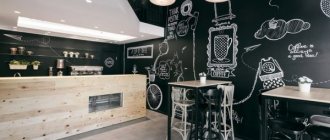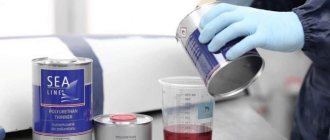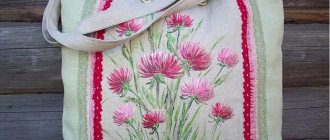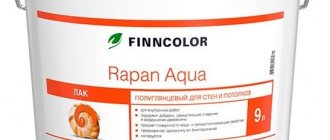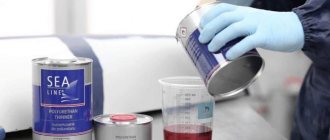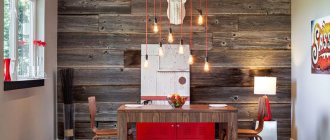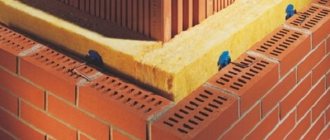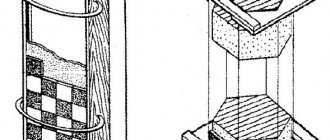In every apartment, house or office there comes a time when it is simply impossible to postpone repairs any longer. Or maybe you’re tired of the color of the facade, tired of the old faded wallpaper.
And now, you are ready to refresh the room with your own hands and change the appearance of the walls. With the decision to renovate, the question arose: “What building materials are best to use?” Paint the walls, or wallpaper the room again? Wallpaper, regardless of price, will not be original, as it is produced in large quantities. Paint with water-based paint and decorate, then the walls will become beautiful, stylish and special.
This article will help you get the job done quickly and efficiently, in which everything is laid out on the shelves: choosing a water-based emulsion, repair processes, painting technology and wall decoration.
Reasons for choosing water-based paint
- Dries quickly.
- Good adhesion (2 layers are enough to obtain a uniform surface color).
- Apply to any surface (concrete, brick, plaster, wallpaper, wood, iron, plastic).
- Diluted with water, using pigment you can achieve the desired color or shade.
- Has no smell.
- Does not cause allergies.
- No harmful fumes.
- Doesn't fade.
- Can be washed and rubbed.
- You can easily repaint it without any problems.
Advantages
High-quality paints based on water emulsions have a lot of positive properties. First of all, this refers to their harmless composition, which means that it will not harm human health.
The water-based emulsion is characterized by the absence of a sharp specific odor and quick drying. Consumers are often interested in how long it takes for water-based paint to dry; professionals say that in some cases this requires about 2 hours. It is possible to apply this paint coating using a unique method - electrodeposition.
The composition allows you to make the color of water-based paint different by adding special pigments. The store has a catalog with shades, and the client can choose any one he likes, and a specialist will prepare the paint material of the desired shade on the spot. Although white water-based paint is most often available on sale. Other advantages are:
- ease of application;
- ease of cleaning tools after painting.
Water-based paints retain their original appearance for a long period without cracking or delamination during use. The main disadvantage is the need to carry out work exclusively at a temperature of +5°C.
Type, characteristics of water-based paints
What does the water emulsion consist of? Water is the main component, plus fillers: various chemical or mineral additives.
Polyvinyl acetate water-based paint
Filler – PVA.
Area of application: dry indoor living spaces.
Covering - ceiling, panels, slopes, wallpaper, drywall, stucco, wood, smooth and porous surfaces.
Silicate water-based paint
The filler is silicate glue.
Scope of application – internal, external.
Covering - internal panels in rooms with high humidity, external: facade, fences, brick, concrete, street decor.
Silicone water-based paint
Filler – quartz, silicone resins.
Scope of application – indoor non-residential premises, outdoor.
Covering - internal panels in industrial premises with high humidity, external: facade walls, basement, plinth.
Acrylic washable water-based paint
Filler – polyacrylate. Additive composition: copolymer or latex.
Scope of application: for interior and exterior work.
Covering - any type of wall panels: facade, roof, base, basement, wood, glass, iron, concrete, stone. Paints porous and textured surfaces well.
Main types
The type of paint will depend on the method of its application, durability, range of applications and degree of resistance. All these parameters are indicated on the jar with the composition. So, let's look at the main types of water-based paints.
Polyvinyl acetate
Such paints belong to the budget category. Their main advantages:
- Versatility. Can be painted in any room.
- UV resistance.
- Complete safety and environmental friendliness.
Polyvinyl acetate mixtures are based on PVA glue. This is why, after some time, light colors can take on a yellow tint.
Expert opinion
Kukushkin Anatoly Sergeevich
Repair specialist
Paints of this type are absolutely not suitable for wet rooms. To care for them, use only the dry method.
Mineral
Another option for budget paints. Their advantages:
- Suitable for decorating any surfaces.
- Resistant to temperature changes.
- Do not interfere with natural air circulation in the room.
The paints contain slaked lime, calcium or cement.
This is ideal for painting concrete or cement walls. However, you should not use mineral compositions in very bright rooms, as they quickly fade under the influence of ultraviolet radiation.
Silicate
This type of coverage belongs to the middle price category.
The paint contains liquid glass. Their advantages are:
- High strength and durability.
- Resistance to temperature changes.
- Preservation of natural steam exchange in the room.
These compositions are perfect for painting concrete and plastered walls indoors. They are not used in the bathroom as they do not tolerate moisture.
This type of water-based paint is used only for interior work in dry rooms. Not suitable for application to metal and stone surfaces.
Acrylic
Manufactured on the basis of acrylic resins. Quite expensive, but at the same time very popular compositions.
Their advantages include:
- Versatility. Suitable for all surfaces.
- Resistance to moisture, ultraviolet radiation, mechanical damage.
- Elasticity. They do not crack over time and cover small wall defects well.
- Low consumption.
- Safety. Such compositions can be used in premises of any purpose.
Acrylic water-based paints are washable. They can be used in apartments where there are small children, as well as in the kitchen.
Latex
This is a subtype of acrylic paints that additionally contain latex, which gives them much greater advantages.
Among the advantages of latex compounds are:
- Resistance to water and temperature changes.
- Easy to maintain, the surface can be washed with water and detergents.
- UV resistance.
- Hiding defects on any surface.
- Quick drying and no unpleasant odor.
- Resistance to fungi and mold.
Such paints are quite expensive, but they have many advantages compared to cheap analogues.
Expert opinion
Kukushkin Anatoly Sergeevich
Repair specialist
Latex-based paints do not allow air to pass through. They are not recommended for painting walls and ceilings in children's rooms, as well as bedrooms. They also do not tolerate exposure to cold and may crack at sub-zero temperatures.
Calculation of calculation of water emulsion
To buy the required amount of water emulsion, you need to make simple calculations. To do this, measure the area of the surface to be painted. Multiply the height H and length L, equal to the area Sst (H × L = S). Then sum up all the areas, subtract the area of windows and doors from this, get the total footage Sob.. Consumption for 1 layer is 150–200 ml of water-based emulsion per 1 m2 of wall. As a rule, 2 layers are needed for high-quality painting. Multiply the total area by 400 ml (Sob. × 400 = N liters). N liters is the required amount of water emulsion.
Tools, consumables
- Narrow spatula for sealing cracks.
- Wide spatula for puttying.
- A narrow brush with short bristles for layering.
- A wide brush with long bristles for priming.
- A small roller for painting in hard-to-reach places behind radiators and pipes.
- Large roller for general painting.
- Painting tray.
- Painting tape to protect the area that will not be painted.
- Sanding sandpaper or mesh for sanding uneven surfaces.
- Polyethylene film to protect furniture floor doors.
- Primer.
Roller for water emulsion
Which roller is best for painting? The roller is a roll covered with a “fur coat”; a handle is inserted into the hole. This table will consider which “coat” is optimal for painting different surfaces.
| view | for which surface |
| Velor | Smooth: plasterboard panels, glass, plastic wood, stucco, moldings |
| Short pile | Smooth: plasterboard panels, concrete, textured wallpaper |
| Medium pile | Smooth, porous, with deep relief: wall panels, facade plaster, brick, decorative stone |
| Long pile | Porous, with deep relief: wall panels, facade plaster, brick, decorative stone |
| Foam smooth | Smooth: walls, concrete, textured wallpaper |
To start painting the walls, you need to remove the old coating, repair it and cover it with a primer. Wall panels can be covered with wallpaper, painted with oil or enamel paint. They may be whitewashed with chalk or lime.
Advantages
Paints of this type have many positive characteristics. The most significant advantages are:
- Excellent coverage, allowing you to hide many defects.
- Safety and environmental friendliness.
- No unpleasant odor characteristic of paint.
- Fast drying.
- Easy to apply and dilute.
- Durability of the coating and durability up to 18-20 years.
- Easy to care for, etc.
In addition, some types of emulsion paints have excellent resistance to moisture, which allows them to be used for painting walls and ceilings in the bathroom.
Any water-based paints meet fire safety requirements and can be used to cover surfaces in children's and medical institutions. A huge color palette allows you to select options for any design solution.
Removing old coating
Removing wallpaper
When gluing wallpaper before the start of European-quality renovations, they used CMC glue, Bustilat or a paste made from flour and starch. Moisten the wallpaper in small areas with a roller, brush or spray, wait about 5 minutes, and clean off with a sharp spatula. In this way, the entire room is cleaned, section by section.
Wallpaper that is glued with modern glue does not have such a strong bond with the surface, so it can be removed in whole sheets or the colored base is removed first, and then the backing.
Removing old paint
Wall panels that have been painted with oil or enamel paint are scraped off with a spatula. To speed up cleaning, the painted surface is “heated” with hot air using a hair dryer. Use the hairdryer carefully and keep your hands away from very hot air. Chemical solvents are also used to remove old paint. Follow safety precautions, wear safety glasses, a respirator, rubber gloves, and thoroughly ventilate the room.
Surfaces that have been whitewashed with lime or chalk. How to test chalk or lime? Wet a section of the wall using a brush. If there is no paint left on the brush, it's lime. The water and the brush turned white, it’s chalk. Whitewashing with lime, you don’t have to remove the whitewash. Whitewash with chalk, wash thoroughly with a brush, until plaster or concrete.
Wash panels that have been painted with water-based emulsion with clean water or a lint-free cloth.
Before applying a high-quality water-based emulsion, and then not repainting, it is advised to take full responsibility for repairing the surface.
How to apply?
The method of applying water-based paint depends on the type of surface and composition. Acrylic and mineral compositions are ideal for painting walls and ceilings in unheated rooms. However, mineral paints lose their original appearance much faster.
To work inside a heated room, for example, an apartment, you can use almost any composition. However, take into account the specifics of the room. For example, not all compositions are suitable for use in the bathroom.
If your task is to transform a bathroom or shower room, opt for silicone, latex or acrylic compounds.
For ceilings, it is best to take silicone-based compounds. They dry quickly, do not drip and allow you to apply paint as accurately as possible.
Application technology
To begin with, it is worth remembering a number of nuances:
- If the paint is applied to a previously prepared and primed surface, 1-2 layers will be enough to achieve the desired effect. That is why, before painting, it is best to spend a little time preparing the walls and ceiling.
- With each subsequent layer, the paint color will look more saturated. But after complete drying, the finishing color becomes several tones lighter than the paint in the can.
- If you want to apply a second coat, let the first one dry. This may take about 6-8 hours.
Water-based paints should dry indoors. The presence of drafts is unacceptable.
Before starting work, you need to prepare the following tools:
Roller.
Brushes.
Sponge.
Paint tray.
Foam rubber-based rollers are not suitable for water-based compositions. Since when using them, the paint may form “bubbles”.
If you are working with a mineral-based composition, it is best to use a spray gun for application. It will allow you to distribute the paint in the corners, making it easier to work with painting the ceiling.
So, the process of painting walls and ceilings may look like this:
Prepare the surfaces. Remove traces of the old coating from them, clean them from dirt, if necessary, fill in uneven areas and prime them.- Cover the floor with film to prevent traces of paint from getting on it. Also cover any items that need to remain clean.
- If the room has a window, then start painting the ceiling parallel to the window, moving from one wall to the other. The second layer is applied perpendicular to the light source.
- Alternate working with a roller and brushes. Where it is not possible to work with a roller, use brushes.
- Try to work as quickly as possible.
- If the paint is applied to wallpaper, one layer will be enough. In all other cases, the paint can be applied in 2 layers or more.
Water-based paints begin to set within 15-20 minutes after application. That is why you need to work with them as quickly as possible. Otherwise, the drying boundary of the layers will be clearly visible.
When working with walls, paint starts from the corner. First, paint the corner itself using a brush, and then take a roller. The paint is applied from top to bottom. Try to make it a continuous stripe.
If the paint's instruction manual says that it needs to be diluted with water, be sure to do so. Otherwise, the composition may lie unevenly and after drying, streaks will form on the surface.
To paint walls and ceilings, you can buy ready-made water-based paint of any color. However, if you wish, you can purchase a white composition and color it yourself.
Water-based paints are perfect for interior work. They are distinguished by a variety of shades, fit well and are suitable for creating complex color transitions or patterns. With proper care and the right choice, such a surface will serve you faithfully for many years.
Repair and preparation of walls for painting
Plastering and puttying walls
After removing the old cladding, the walls were exposed and all the flaws were revealed: cracks, unevenness. It is advisable to tap the walls to identify voids in the plaster. If the sound is muffled, the wall is not damaged. The sound is loud, it is advisable to hollow out this area. Why do this? Over time, the weak plaster will peel off and fall, leaving a gaping hole in the painted panels. To eliminate problem areas you will need: cement mortar, starting or finishing putty.
Open up the cracks. This is done like this: insert a spatula into the crack with a sharp edge, and pick out the plaster along the entire line as far as possible.
Moisten all damage with water and putty with finishing putty. If the depth is more than 2 cm, putty as a start or add sand to the finishing putty in a 1:1 ratio. Rooms with high humidity or exposed to climatic influences should be plastered with cement mortar (cement 1: 4 sand).
Areas plastered with lime or cement mortar, with tenacious oil paint, should be puttied on top with a thin layer of finishing putty.
Grinding
The putty has dried, now the sanding process begins. All sandpaper, depending on the grain size of the abrasive, is marked with numbers. Rough transitions, grooves, are sanded with abrasive grain size from No. 40 to No. 80, weakly expressed from No. 100 to No. 140. Grinding can be done manually, using a carriage or an electric grinder.
Priming walls before painting
For better adhesion of layers of material and deep impregnation, the surface is primed. Priming should not be neglected, as the water-based emulsion will not adhere well, peel and crack. The primer liquid is purchased depending on the surface that will be painted. Penetrating primer for wooden, brick, concrete, plaster and putty substrates. For areas in rooms with high humidity, for the street, a concrete contact primer is used. The primer contains additional fungicides, protection against mold and mildew.
After sanding, be sure to blow off the dust with a vacuum cleaner or a dry soft brush.
Apply the primer to a dry surface with a roller, a wide brush with long bristles or a spray gun.
Technology of painting walls with water-based emulsion
Before painting, the room must be prepared and cleared of unnecessary items. Use masking tape to seal sockets, switches, and corners between the ceiling and wall panel. Cover the perimeter of the floor with plastic film. Also protect the doors with film.
Open the paint, thoroughly mix the contents of the bucket until smooth, mechanically (with a drill attachment) or manually (with a dry, strong stick). Add color or pigment and mix again. Pour into a paint tray or smaller container. Paint the walls with a roller, brush or spray gun
The first layer is slightly diluted with water 1:10.
Do not thin the second layer.
Apply the water-based emulsion from top to bottom and continue working according to the light flux from the window.
Flaws
Despite the huge range of advantages, these compositions are not without disadvantages.
For example, the disadvantages include:
- The need to maintain temperature conditions during the application process. At temperatures below -5 degrees the paint will simply freeze.
- Some types of compounds are not suitable for metal and plastic surfaces.
- The cheapest water-based paints quickly lose their original appearance.
That is why, when planning to paint walls and ceilings with water-based paints, carefully read the instructions for their use. You can also ask a sales consultant for advice.
Water-based paint application technology
Dip the roller into the tray and rotate it so that the paint evenly covers the roller. Visually divide the surface into 1m2 sections. Using a roller, draw 2-3 lines vertically in the middle of the area. And quickly shade horizontally, then vertically. The process is repeated on each section of the wall. The border of transitions between areas is shaded with a semi-dry roller.
Decorating walls with water-based paint
Show your imagination, use water-based paint, and make a work of art out of the walls with your own hands. Apply masking tape to the panel in strict or smooth lines and paint each section a different color.
You can use this option for finishing: make full or mixed structure of the walls. Add color and dry putty to the water-based washing paint and mix thoroughly. Apply the mixture with a spatula, roll it out with a roller; the depth of the relief will depend on the length of the pile.
The content of this article is to encourage a person to take action, to change the world around him for the better. Are you ready for this?
Popular manufacturers
Water-based paint from a trusted manufacturer is the key to successful repairs, since high-quality paint will give an excellent result.
- Tikkurila. One of the most environmentally friendly and durable paints on the market.
- Dufa. It has a high cost, but the highest quality parameters.
- Dulax. Also offers high quality paint.
- Snowball. Inexpensive paint with a rich palette of colors.
- Lakra. Good quality paint at an affordable price.
